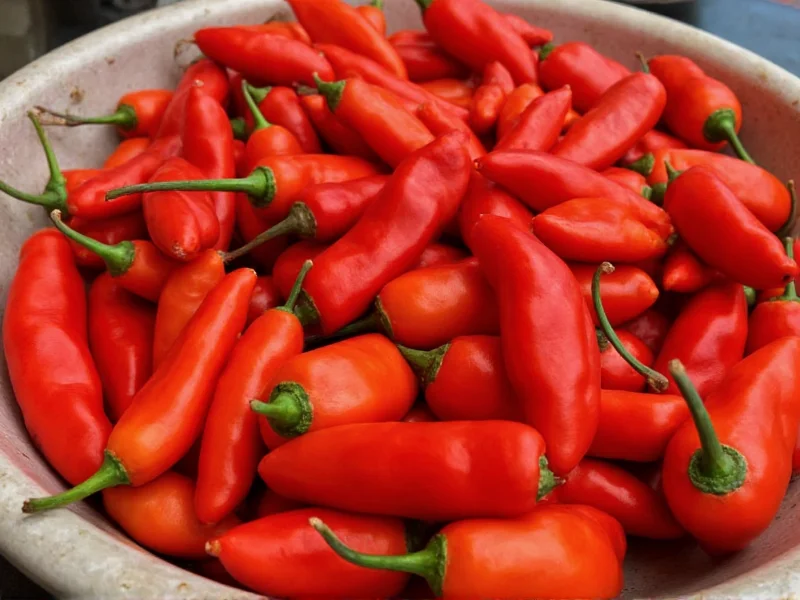Understanding the precise heat level of guajillo peppers is essential for home cooks and professional chefs alike. These distinctive red, wrinkled peppers—technically the dried form of the fresh mirasol chili—are staples in Mexican cuisine, prized for their complex flavor profile that extends far beyond mere spiciness.
Decoding the Scoville Scale for Guajillo Peppers
The Scoville scale measures chili pepper heat by determining capsaicin concentration—the compound responsible for that characteristic burn. Guajillo peppers consistently register between 2,500 and 5,000 Scoville Heat Units, which positions them as approachable for most palates while still providing noticeable warmth.
What makes guajillo peppers particularly valuable in cooking is their balanced heat-to-flavor ratio. Unlike many hotter chilies that prioritize burn over taste, guajillos offer nuanced notes of berry, tea, and subtle tanginess that complement their mild heat. This dual characteristic explains why they're frequently used as base ingredients in complex sauces rather than as primary heat sources.
Guajillo Pepper Heat Comparison Chart
| Pepper Variety | Scoville Heat Units (SHU) | Heat Level |
|---|---|---|
| Bell Pepper | 0 SHU | Mild |
| Poblano | 1,000-2,000 SHU | Mild |
| Guajillo | 2,500-5,000 SHU | Medium-Mild |
| Jalapeño | 2,500-8,000 SHU | Medium |
| Serrano | 10,000-23,000 SHU | Medium-Hot |
| Cayenne | 30,000-50,000 SHU | Hot |
Factors Influencing Guajillo Pepper Heat
Several variables affect the actual heat you'll experience when using guajillo peppers:
- Growing conditions—Soil composition, climate, and water availability impact capsaicin production
- Ripeness at harvest—Fully mature peppers develop more complex flavors with balanced heat
- Preparation method—Removing seeds and membranes reduces heat significantly
- Storage duration—Heat diminishes gradually over time as capsaicin breaks down
When comparing guajillo to ancho peppers (dried poblanos), guajillos typically register slightly higher on the heat scale while offering brighter, fruitier notes. This makes them excellent for dishes where you want perceptible warmth without dominating other ingredients—a key consideration when exploring how hot are guajillo peppers compared to alternatives.
Practical Applications in Cooking
The moderate heat level of guajillo peppers makes them exceptionally versatile. Unlike hotter chilies that require careful measurement, guajillos can be used more liberally to build flavor foundations. Traditional Mexican dishes like chile colorado, mole sauces, and adobos rely on guajillos for their characteristic warmth and rich color.
When rehydrating guajillo peppers for sauces, their heat distributes evenly throughout the liquid base. This characteristic makes them ideal for understanding how hot guajillo peppers affect finished dishes—typically providing background warmth rather than upfront burn. For those concerned about excessive heat, removing seeds before rehydration reduces spiciness by up to 50% while preserving flavor.
Guajillo Pepper Substitutes
If you're wondering how hot are guajillo peppers and need alternatives, consider these options:
- Ancho peppers—Slightly milder (1,000-2,000 SHU) with chocolatey notes
- Pasilla peppers—Similar heat range (1,000-2,500 SHU) with earthier flavor
- Mild paprika—Provides color and subtle warmth without significant heat
- Chipotle morita—For smokier profiles with comparable heat (2,500-5,000 SHU)
Understanding guajillo pepper heat intensity helps determine appropriate substitutions. While pasilla peppers offer similar heat levels, they lack guajillo's distinctive berry notes. Anchos provide milder heat but with deeper, raisin-like flavors. This knowledge proves invaluable when adjusting recipes based on available ingredients and desired heat outcomes.
Handling and Safety Considerations
Despite their medium-mild classification, proper handling remains important when working with guajillo peppers. Always wear gloves when processing large quantities, and avoid touching your face. The capsaicin oils can transfer to sensitive areas, causing discomfort even with relatively mild peppers.
When determining how hot guajillo peppers might affect your specific dish, consider these practical tips:
- Start with fewer peppers than recipe suggests, then adjust after rehydration
- Balance heat with acidic components like lime juice or vinegar
- Combine with sweeter ingredients to counteract perceived spiciness
- Remember that heat perception increases as dishes cool











 浙公网安备
33010002000092号
浙公网安备
33010002000092号 浙B2-20120091-4
浙B2-20120091-4